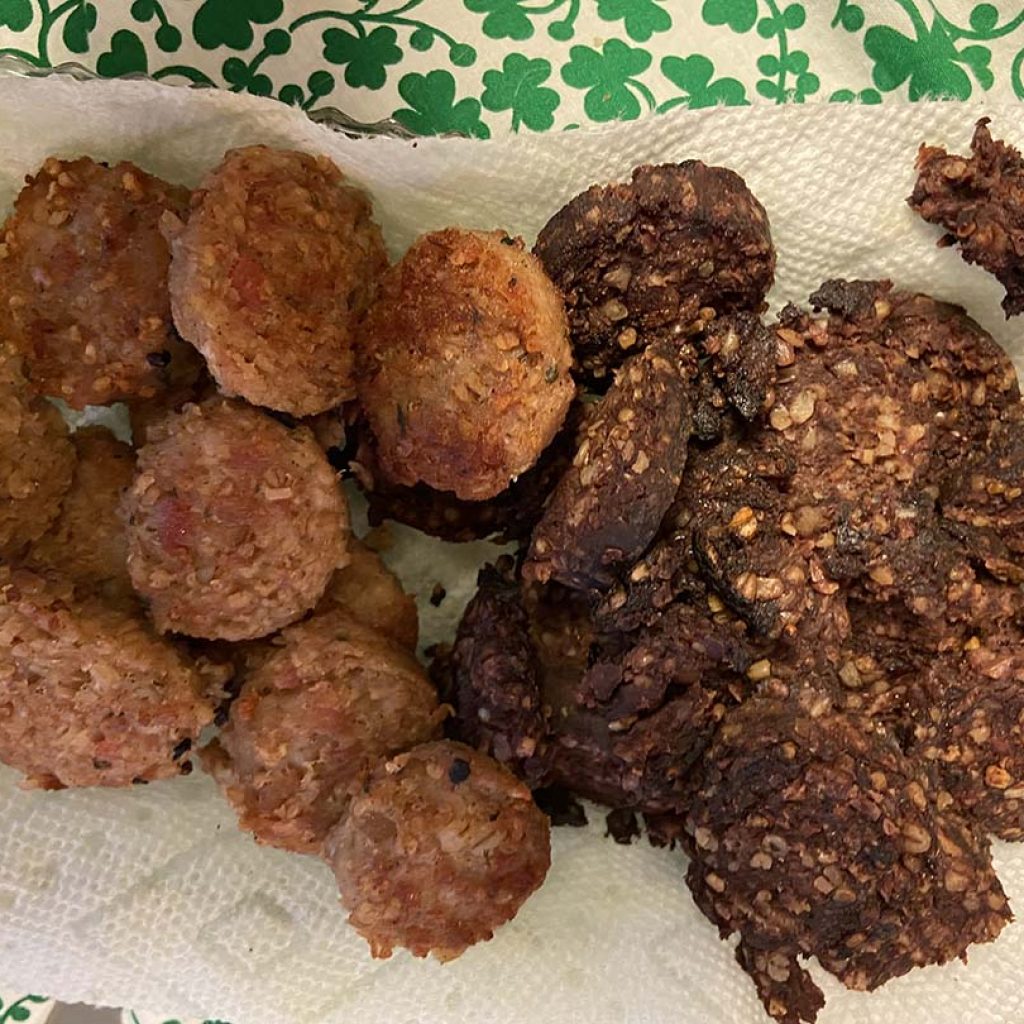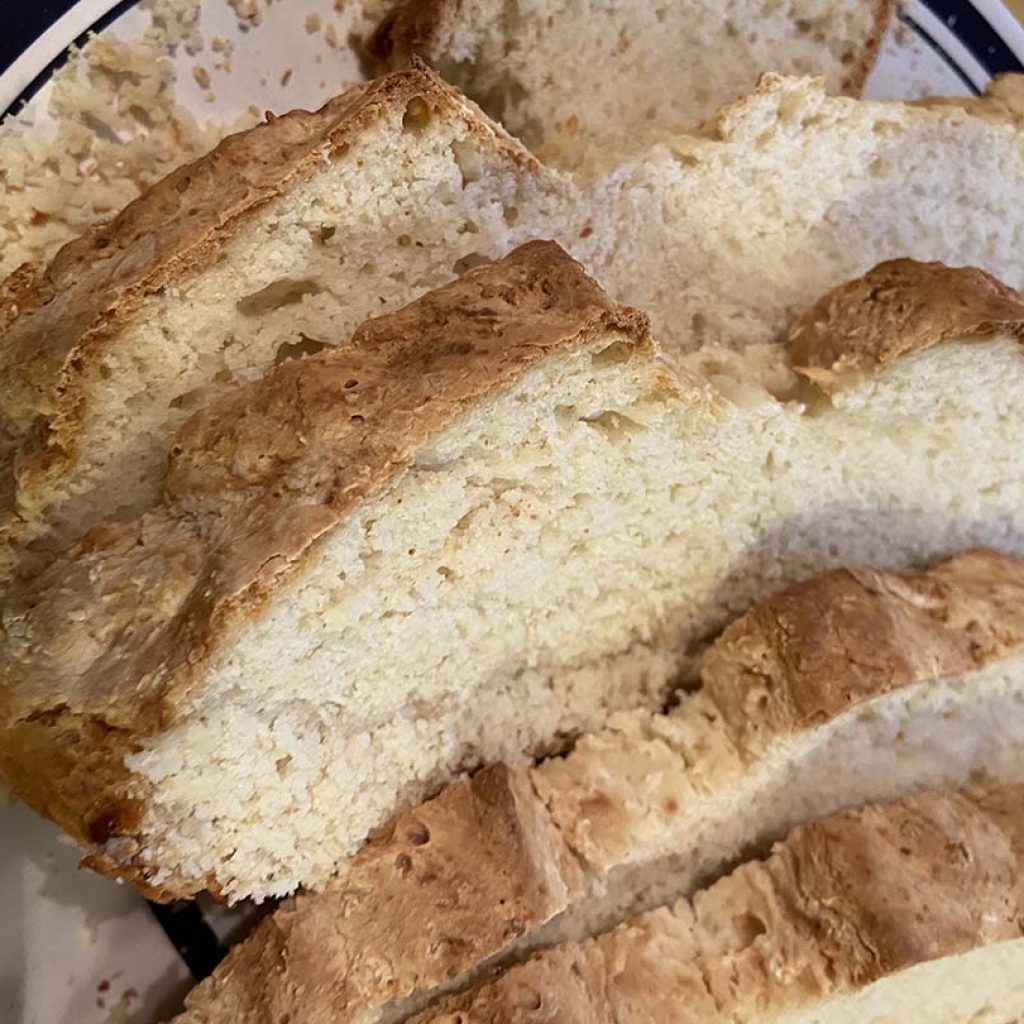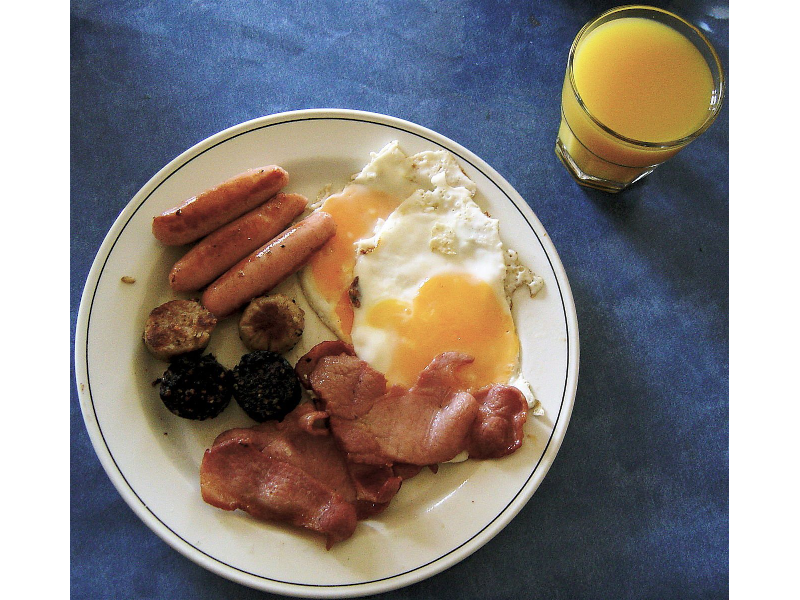Corned beef and cabbage. Irish stew. Guinness. Those are probably the foods on most peoples’ minds as St. Patrick’s Day approaches. But with the exception of Guinness, those are actually Irish-American foods more than they’re Irish food.
A visitor to Ireland is far more likely to encounter bacon and cabbage – bacon in Ireland is roughly the equivalent of our country ham—than corned beef and cabbage. Irish stew – not so common. You actually see chicken curry on more menus than Irish stew. In the area of soups, a thick, rich, pureed vegetable soup served with Irish soda bread is on almost every menu I’ve ever seen in my travels to Ireland.
What most people come home raving about after visiting Ireland isn’t the entrées, though. It’s the full Irish breakfast. My husband casts a dubious eye on the full Irish breakfast and refers to it as a heart-attack-on-a-plate, but he doesn’t deny that it’s one of the high spots of Irish cuisine.
[adrotate banner=”31″]
The heart attack reference is because a traditionally prepared full Irish breakfast is almost all fried – a fried egg, fried potatoes, fried bacon, fried sausage, fried white and black pudding, accompanied by grilled tomatoes, grilled mushrooms, toast and brown bread. Some places add baked beans, but those seem to be more commonly British than Irish.
Most of the items on that list are pretty familiar, but the tastes are different. Unique is probably a good description. The bacon, of course, is “hammier” than ours, and the Irish sausage, while pork, is not as heavily spiced as American pork sausage. Actually, I don’t think it’s spiced at all. The white and black puddings are probably the two truly foreign items in that list. With good reason.

Staff photo by Debbie Reddin van Tuyll
Americans don’t do much with savory puddings. We associate the word pudding more with sweet milk-based desserts. White and black puddings are about the opposite of that. They’re savory mixtures of pig parts we won’t discuss and other ingredients that are stuffed into a casing like sausage. The puddings do have a little more spice, and the black pudding has a “special” ingredient that often turns Americans a little squeamish – blood. That’s how it gets its black coloring.
You won’t need recipes to prepare this mean, but you will need to know where to get the the basic ingredients. A couple of British shops in Atlanta carry most of the specialty meats. One is in Norcross. It’s called Taste of Britain, and its website is https://tasteofbritain.com/. The other is the Queen’s Pantry in Marietta. Its website is https://stores.thequeenspantry.com/. These shops won’t ship frozen foods, so you have to make the trip to the store.
If you’re like me and can’t get to Atlanta often, but you can still get the Irish breakfast foods online. They’ll be delivered, packed in dry ice, directly to your doorstep.
I’ve ordered in the past from a website called Food Ireland. Its website is irishfood.com. It’s my favorite site to order from. I didn’t know the site existed until my daughter gave me a gift card from them one Christmas. Prices are pretty reasonable from that site. A basket with everything you’ll need to serve 3-4 people (except the eggs) is only about $40. You can probably actually feed 6-8 with the items in that basket. Irish cooks are a lot like Southern cooks. They’re offended if you don’t leave the table absolutely stuffed. You can usually double serving estimates from Ireland and be okay.
A site devoted entirely to Irish breakfast is, again uniquely, named Irish Breakfast USA. Its url is https://irishbreakfastusa.com/. If you want to go whole hog, you should order the Premium Irish Breakfast. It offers three packages of bacon, three packages of sausage, two each of the puddings, Kerry Gold butter, Irish soda bread, marmalade, Barry’s Tea, and a can of Batchelors Baked Beans. That runs $99.99.
Only order that if you need the extra meat. You don’t need to order the other items in the package. You can get the rest here in Augusta.
[adrotate banner=”19″]
Publix carries the baked beans, just about everywhere has Kerry Gold butter, marmalade is marmalade, and no two Irish that you talk to can agree on which is the best tea. The argument is usually over Barry’s or Lyons. Well, Publics has Barry’s if you want to try it, but the best Irish breakfast tea I know is Bewley’s Dublin Morning tea. Bewley’s is a sandwich shop chain that’s popular in Dublin. Amazon carries some of their teas, so most of the “extras” in the premium pack, you can get at your regular grocery story or Publix.
Even though the the delivery packages include soda bread, you really want to make your own. Homemade is just soooooo much better and it’s so easy to make. I don’t know why anyone ever buys the packaged kind. Again, just about everyone has their own spin on how to make Irish soda bread. I have my favorite recipe, which I offer below, but it’s also worth looking at the ones from the Society for the Preservation of Irish Soda Bread.

The people at this definitive website are devoted to ensuring the world knows how to make actual, true Irish soda bread. They say the most authentic soda bread contains four ingredients: flour, baking soda, buttermilk, and salt. Period. No currents. No candied fruit, raisins or carraway seeds. Nothing, nada, zip, zilch, nil. According to the website’s recipe booklet, “There are recipes for those types of cakes but they are not the traditional soda bread eaten by the Irish daily since the mid-19th century.”
Most people I know don’t keep buttermilk in the fridge, and if you’re one of those, don’t worry. It’s easy to make your own. In your one-cup measuring cup, add one tablespoon of white vinegar before you fill the cup up with regular milk. Voila – a substitute for buttermilk. The vinegar reacts with the baking soda to become a leavening agent, just like the buttermilk would.
So, the recipe for this week is for soda bread. This one is very similar to those offered by the Society for the Preservation of Irish Soda Bread. It just makes a larger loaf. You’ll need to eat it in a day or so. Soda bread doesn’t stay fresh for long, and the larger loaf gives you a good excuse to slice it right out of the oven, slather on the Kerry Gold and be transported to the Emerald Island with your first bite.
Irish Soda Bread
2 c. all-purpose white flour
1 ¾ c. whole wheat flour (or, when I have it, I like to use white whole wheat flour)
2-3 tbs. extra flour for dusting the loaf before kneading
1 ½ tsp. baking soda
1 ½ tsp. salt
2 c. buttermilk (or substitute described above)
Preheat your oven to 450 degrees F. Grease a cast iron skillet or Dutch oven with some butter and sprinkle it with flour, or use an aerosol baking spray to coat the bottom of the skillet or Dutch oven.
[adrotate banner=”23″]
Whisk together both flours (except for the extra flour), baking soda and salt together in a large bowl. Add the buttermilk and stir until it’s too hard to stir. You want a wetter dough because that will give you a moister bread, but you only want the dough dry enough to shape and move easily. You can add some extra flour if needed during the kneading phase.
Once you add the buttermilk, your objective is to get the bread in the oven in the next three minutes. That’s because the buttermilk activates the rising power of the soda, and you want to get the bread in the oven before all that is lost.
So, you may want to have your kneading area prepared before you add the buttermilk. To prepare the kneading area, sprinkle the extra flour on a piece of waxed paper. Once you’ve added the buttermilk and stirred enough to get it incorporated, turn your dough out onto it. Knead briefly – no more than 10 times. If you knead too much, the bread will become tough. End up with the dough in a ball. Transfer the ball to your lined baking sheet. Pat it down until it fills your pan and is a consistent thickness. Cut a deep X into the top of the dough with a serrated knife. This allows steam escape more easily.
Bake 20 minutes and then turn your oven down to 390 degrees F and bake another 20 minutes. Depending on how thick your dough is in your pan, it may need a few minutes more or less, so just keep an eye on it as you go along. Transfer to a wire rack and let cool for 30 minutes before cutting. This last step will be your hardest, but make yourself wait. The bread will cut way more easily if it has a chance to cool down a little first.
Debbie Reddin van Tuyll is Editor-in-chief of The Augusta Press. Reach her at debbie@theaugustapress.com
[adrotate banner=”36″]












